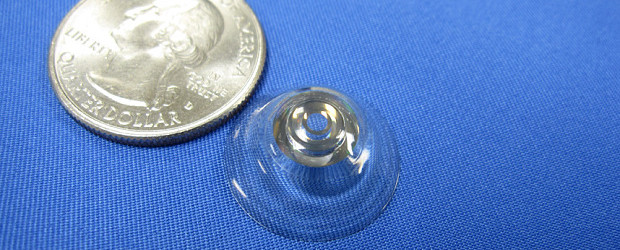
People with the most common form of sight loss could regain their vision with a new contact lens that has an in-built telescope.
The lens, which could help 500,000 British sufferers of age-related macular degeneration (AMD), increases peripheral vision three-fold. It could be available in two years and is safer and cheaper than surgery, Swiss scientists say.
The lens works in conjunction with glasses and is activated by winking. The user winks with their right eye which triggers the lens to zoom in. They wink with their left to turn off the telescope.
AMD is the biggest cause of sight loss in Britain with sufferers losing their ability to see in the centre of their field of vision, making it difficult to read and recognise faces.
Sufferers, therefore, need to use their peripheral vision instead. This ability will be made easier by the contact lenses.
Dr Eric Tremblay, a designer from the Swiss Federal Institute of Technology, said the magnifying contacts would allow people with sight loss to read text more easily and see faces.
Presenting a working prototype at an annual science conference in California, he said: “The contact lens has a very thin telescope built into it — it allows you to have magnified vision. So it makes the object that you look at bigger.
“The most compelling reason why you would want to have this is to help people with serious visual problems, such as macular degeneration, or other retinal illnesses where people have severe vision loss.
“In a lot of cases magnification is very useful. So what people usually use are head-mounted telescopes which don’t work for everything.”
The lenses have tiny telescopes built into the centre which work in the same way as looking through binoculars.
To activate the lens, users must be paired with specially adapted glasses that recognise winks, but ignore blinks.
The contact lenses have two apertures, one which is magnified and one normal.
When users shut their right eye, the glasses change the polarisation of light so that it hits the contact lens at the right angle to trigger the magnification effect. A wink with the left eye effectively turns off the telescope.
“It is instant. You wink and the image changes. It rests on the white part of your eye and is quite large and quite thick,” Dr Tremblay added.
There are already glasses on the market for those with AMD which have mounted telescopes, but they tend to look bulky and interfere with social interaction.
They do not track with head movement so users must position the eyes and tilt the head to use them.
Currently, a small telescope can be surgically inserted into the eye but the operation can cost around £6,000.
The new lenses are likely to be far cheaper. The breakthrough was welcomed by charities, which said that it could help sufferers of sight loss with daily tasks, such as driving and reading instructions on medication.
Clara Eaglen, eye health campaigns manager at the Royal National Institute of Blind People, said: “It is encouraging that innovative products such as these telescopic contact lenses are being developed, especially as they aim to make the most of a person’s existing vision.
“Anything that helps to maximise functioning vision is very important as this helps people with sight loss to regain some independence.”
She added: “The more sight someone has, the more they are able to live safe, independent lives. This could mean not having to give up driving, remaining in employment, being able to cook safely and read medication instructions.
“This research is still at an early stage but it will be exciting to watch how it progresses.”
Cathy Yelf, the acting CEO of the Macular Society, said: “There is virtue in having a zoomable contact lens for some people with macular degeneration who have lost their central vision. We will be interested to see how, in practice, it works for people with AMD. With an ageing population, investment in research and new treatments is a pressing issue as there are 600,000 people in the UK with this form of sight loss.”
The research was presented at the American Association for the Advancement of Science annual conference in San Jose, California.
This article was originally published on telegraphco.uk Read the original article.